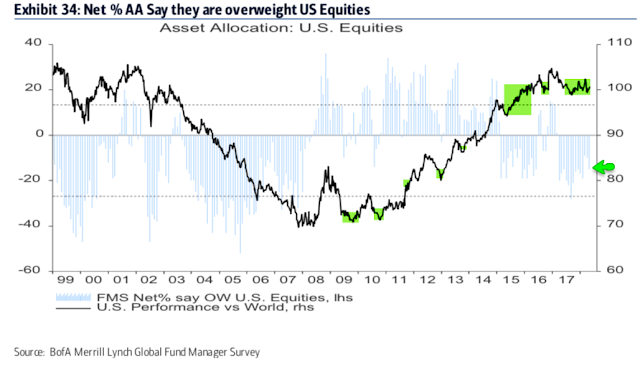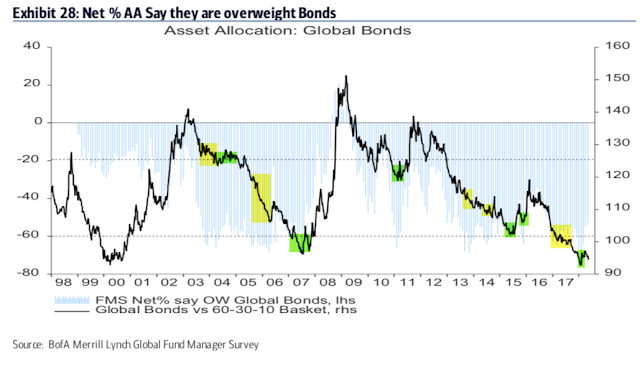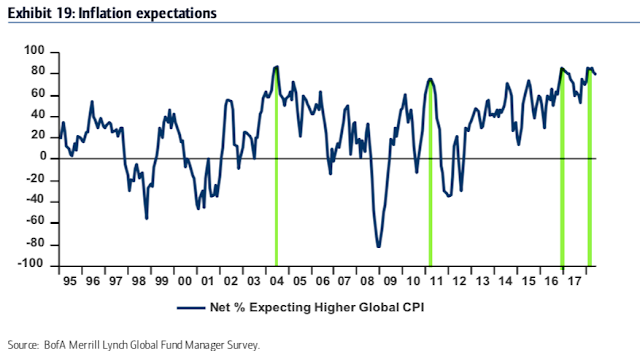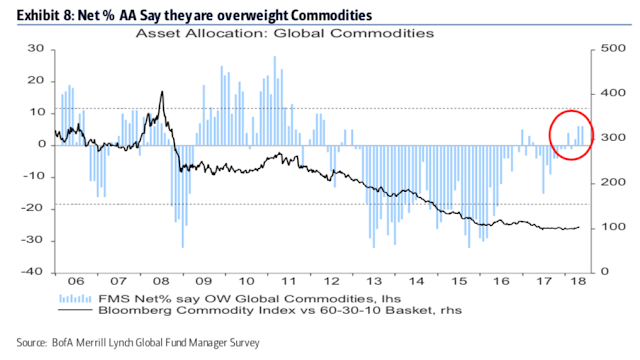by Urban Carmel, The Fat Pitch
Summary: Fund managers came into 2018 very bullish equities. Cash levels had fallen to the lowest level in 4 years. Allocations to global equities had risen to the highest level in nearly 3 years. Bond allocations were at a 4 year low. Our view at the time was that "this is a headwind to further gains" in equities. That post is here.
Since then, global equity allocations have fallen and cash balances have risen. Investors are no longer at a bullish extreme, although the equity correction has not (yet) made them outright fearful.
In the past 9 months, US equities have outperformed Europe by 6% and the rest the world by 5%. Despite this, fund managers remain underweight the US. US equities should continue to outperform their global peers on a relative basis.
Fund managers' inflation expectations are near a 14 year high; in the past, this has corresponded with a fall in US 10 year yields in the months ahead. Commodity allocations are at a 6 year high.
* * *
Among the various ways of measuring investor sentiment, the Bank of America Merrill Lynch (BAML) survey of global fund managers is one of the better as the results reflect how managers are allocated in various asset classes. These managers oversee a combined $600b in assets. Our sincere gratitude to BAML for the use of this data.
The data should be viewed mostly from a contrarian perspective; that is, when equities fall in price, allocations to cash go higher and allocations to equities go lower as investors become bearish, setting up a buy signal. When prices rise, the opposite occurs, setting up a sell signal. We did a recap of this pattern in December 2014 (post).
Let's review the highlights from the past month.
Overall: Relative to history, fund managers are overweight cash and commodities, underweight bonds and neutral equities. Enlarge any image by clicking on it.
Within equities, the US is significantly underweight while Europe, Japan and emerging markets are all overweight.
A pure contrarian would overweight US equities relative to Europe and emerging markets and underweight cash.
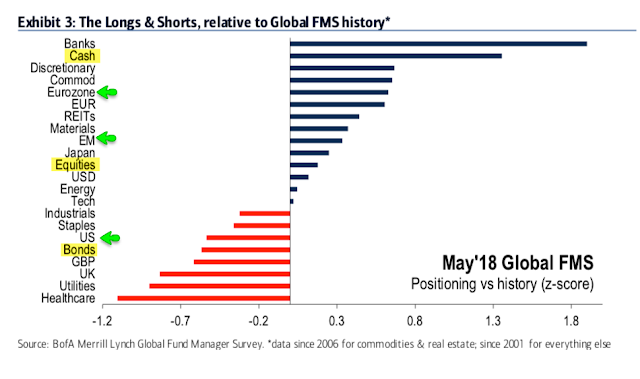
Cash: Investors' cash balance is high at 4.9% (BAML considers cash levels above 4.5% to be a contrarian long for equities). This is still supportive of further gains in equities. A recap:
Fund managers' cash levels rose to 5.8% in October 2016, the highest cash level since November 2001. This set up a contrarian long in equities.
Cash remained near 5% until November 2017, when it fell to 4.4%, the lowest level since October 2013.
With the equity sell off, cash rose to 5% in April and remains high in May; this is a tailwind for equities.
Likewise, fund managers are a net + 37% overweight cash (+1.4 standard deviations above its long term mean). In the context of a bull market, cash should underperform a 60-30-10 basket.

Global equities: After reaching a bullish extreme in January 2018, global equity allocations have fallen back to neutral. A recap:
Fund managers were just +5% overweight equities at their low in February 2016; since 2009, allocations had only been lower in mid-2011 and mid-2012, periods which were notable bottoms for equity prices during this bull market.
By January 2018, equity allocations had increased to +55% overweight, the highest level in nearly 3 years. Outside of 2013-14, over +50% overweight has historically been bearish (dashed line and shading). Our view was that "this is a headwind to further gains."
After the recent correction, equity allocations fell to 29% overweight in April, the lowest in 18 months. In May, allocations to equities are only slightly higher at +34% overweight (+0.2 standard deviations above its long term mean). This is neutral. Investors never became outright fearful during the recent shakeout, but sentiment is no longer at a bullish extreme.
Only 10% of fund managers expect profits to improve in the next 12 months, the lowest in 1-1/2 years (red line).
Macro expectations have fallen hard in recent months. Only a net 1% expect a better economy in the next year - the lowest since equities bottomed in early 2016 - down from a net 47% in January 2018. Investors are now relatively bearish on the global economy.

US equities: US equities are still out of favor and should continue to outperform. A recap:
Fund managers were underweight US equities for a year and a half starting in early 2015, during which US equities outperformed.
From December 2016, to February 2017, investors overweighted US stocks. US equities underperformed their global peers.
In September 2017, investors again became bearish US equities, giving them the lowest allocation in 10 years. US equities have since outperformed.
Fund managers are still bearish on US equities. Allocations in May were -15% underweight (-0.5 standard deviations below its long term mean). This remains a tailwind for the US on a relative basis. Above +20% overweight and sentiment typically becomes a strong headwind (dashed line).
Note that the relationship between performance and weighting worked less well in the prior expansion cycle (2003-07) as emerging markets outperformed developed markets by about 5 times.
European equities: European equities remain the most favored region in the world, and are still at risk of underperforming. A recap:
Fund managers had been excessively overweight European equities in 2015-16, during which time European equities underperformed.
That changed in July 2016, with the region becoming underweighted for the first time in 3 years. The region then began to outperform.
Allocations to Europe have been excessively overweight the past year, during which time the region has underperformed.
Allocations were +34% overweight in May. This is still above neutral (+0.6 standard deviations above its long term mean) and Europe is the most favored region in the world. European equities remain at risk of underperforming.
Emerging markets equities: Emerging market equities are now neutral after being a strong consensus long (and contrarian short). A recap:
In January 2016, allocations to emerging markets fell to their second lowest in the survey's history (-33% underweight).
As the region outperformed in 2016, allocations rose to +31% overweight in October 2016, the highest in 3-1/2 years. That made the region a contrarian short: emerging equities then dropped 10% in the next two months.
Allocations fell to -6% underweight in January 2017, making the region a contrarian long again: the region then outperformed.
In April, allocations rose to +43% overweight, near a 7 year high. In the past two months, the region has underperformed the US by 800bp.
In May, allocations fell to +27% overweight, the lowest since November 2016 (+0.3 standard deviations above its long term mean). This is now neutral.
Global bonds: Bond sentiment has improved in recent months; they are a modest contrarian long. A recap:
In July 2016, global bond allocations rose to -35% underweight, nearly a 3-1/2 year high. Bonds subsequently underperformed a 60-30-10 basket.
In January 2018, allocations to bonds dropped to -67% underweight (-1.2 standard deviations below its long term mean), a 4 year low. This was a capitulation low, and US 10 year treasuries outperformed US equities (NYSE) by about 1000bp in the next two months.
In May, allocations rose to -54% underweight (-0.6 standard deviations below its long term mean). There is still a contrarian tailwind behind bonds, but it has been significantly reduced in the past several months.
79% of fund managers expect higher inflation over the next 12 months; this is near a 14 year high. Higher inflation is a strongly consensus view (first chart). In the past, the consensus view has corresponded to a drop in US 10-year yields in the months ahead (second chart).
Higher inflation expectations goes in hand with higher commodity allocations: in May, fund managers' were a net +6% overweight (+0.7 standard deviations above its long term mean), the highest in 6 years.
Survey parameters are below.
- Cash: The typical range is 3.5-5.0%. BAML has a 4.5% contrarian buy level but we consider over 5% to be a better signal. More on this indicator here.
- Equities: Over +50% overweight is bearish. A washout low (bullish) is under +15% overweight. More on this indicator here.
- Bonds: Global bonds started to underperform in mid-2010, 2011 and 2012 when they reached -20% underweight. -60% underweight is often a bearish extreme.
- Commodities: Higher commodity exposure goes in hand with improved sentiment towards global macro and/or inflation.
Copyright © The Fat Pitch









